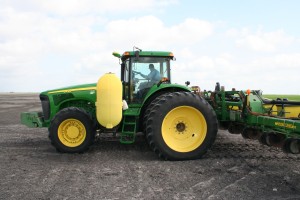This is one of the posts in the Cotton 101 series to introduce people to the basics of cotton farming.
Cotton is a warm weather plant and doesn’t like wet feet at all. That simple sentences guides a lot of planting thoughts for the crop. Like all crops, at planting you want to be sure you have the depth set correctly for the soil type, etc.
 Raised Beds for Planting — Depending on the soil types and typical moisture availability, some people will “bed up.” By creating raised beds a farmer can help channel water where they want it. My first cotton farm visit was to Mr. Ray Young’s in Wisner, La. I was there in the winter and the fields were perfectly in rows for the stale seedbed planting to come. He helped pioneer this version of conservation tillage as the beds would help him keep the seed in moisture but not too wet.
Raised Beds for Planting — Depending on the soil types and typical moisture availability, some people will “bed up.” By creating raised beds a farmer can help channel water where they want it. My first cotton farm visit was to Mr. Ray Young’s in Wisner, La. I was there in the winter and the fields were perfectly in rows for the stale seedbed planting to come. He helped pioneer this version of conservation tillage as the beds would help him keep the seed in moisture but not too wet.
A couple of years later I made my first visit to a farm in West Texas where they bedded up in order to plant between the raised beds. That way water could reach the seed in that truly dryland area. And in lots of places they plant to a level field. Different strokes for different folks or conditions.
Temperatures — A general guideline for planting from a temperature perspective is to wait for 65 degree soil temps at 8 am at a depth of 4-6 inches. You want to get that same temp for a few days and have favorable weather conditions (air temperature and sunlight), as well as consider the moisture, soil texture and ground cover.
One of the considerations that distinguishes cotton from some of the other major Southern crops like rice and soybeans is row spacing. Cotton is planted on rather wide rows (most farmers I know use 38-inch rows or something similar). With the humidity that plaques so many areas of the Cotton Belt, that wide spacing allows a bit more air to get through the crop and lessens the likelihood of late season issues with boll rot. Of course, this can give farmers a tough time as it takes longer for the crop to canopy and the increased spacing allows for more sunlight to get through encouraging weeds later into the season.
Consistency of row spacings is important since equipment rolls through the field for insect or weed control as well as harvest. And unlike a combine a cotton picker leaves the majority of the plant standing in the field so if the spacings aren’t consistent, you can really big problems at harvest.





[…] planters filled more quickly & efficiently to keep tractors moving. As I mentioned in a post on planting considerations, some farmers plant on beds and others plant on flat ground. Similarly some use small planters […]